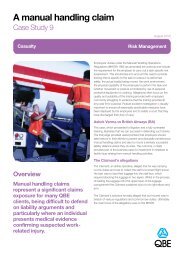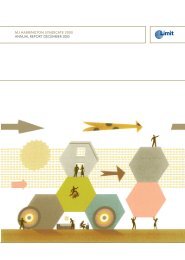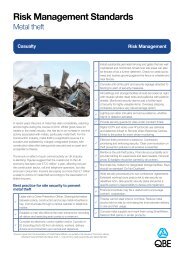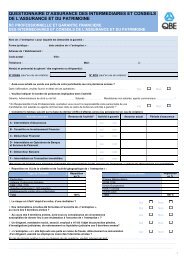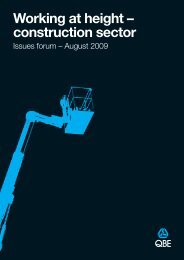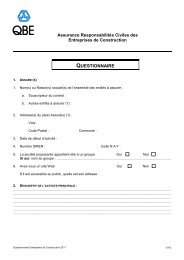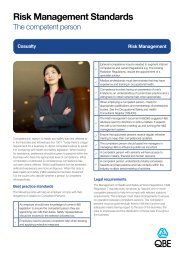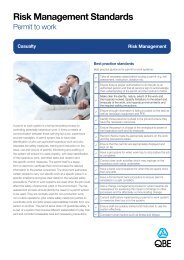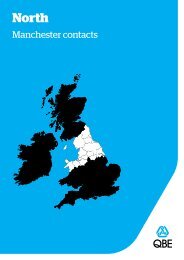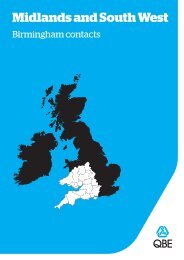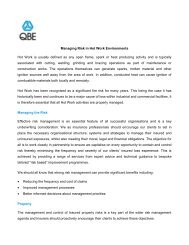QBE Underwriting - Syndicate 0386
QBE Underwriting - Syndicate 0386
QBE Underwriting - Syndicate 0386
Create successful ePaper yourself
Turn your PDF publications into a flip-book with our unique Google optimized e-Paper software.
July 23, 2009<strong>QBE</strong> <strong>Underwriting</strong> - <strong>Syndicate</strong> <strong>0386</strong>Primary Credit Analyst:Ali Karakuyu, London (44) 20-7176-7301; ali_karakuyu@standardandpoors.comSecondary Credit Analyst:David Laxton, London (44) 20-7176-7079; david_laxton@standardandpoors.comTable Of ContentsLloyd's <strong>Syndicate</strong> AssessmentFinancial Strength Ratings And Lloyd's <strong>Syndicate</strong> AssessmentsMajor Assessment Factors:RationaleOutlook<strong>Syndicate</strong> Profile: The Leading Specialist Non-U.S. Liability <strong>Syndicate</strong> AtLloyd'sCompetitive Position: A Recognized Leader Within Its Core MarketsManagement And Corporate Strategy: Long, Established Track Record OfProactive Cycle ManagementAccounting: High Level Of Transparency MaintainedEnterprise Risk Management: Strong Risk Management FrameworkOperating Performance: Consistent, Material Outperformance Of TheLloyd's Market AverageInvestments: Low Appetite For Investment Risk Set To Persistwww.standardandpoors.com/ratingsdirect 1Standard & Poor's. All rights reserved. No reprint or dissemination without S&P's permission. See Terms ofUse/Disclaimer on the last page.735579 | 300972161
Table Of Contents (cont.)Liquidity: Considered StrongCapitalization: Strong Overall, Partly Reflecting The Capital Position At<strong>QBE</strong>Financial Flexibility: Closely Strategically Aligned With The <strong>QBE</strong> GroupStandard & Poor’s RatingsDirect | July 23, 2009 2Standard & Poor's. All rights reserved. No reprint or dissemination without S&P's permission. See Terms ofUse/Disclaimer on the last page.735579 | 300972161
<strong>QBE</strong> <strong>Underwriting</strong> - <strong>Syndicate</strong> <strong>0386</strong>Lloyd's <strong>Syndicate</strong> Assessment5/Stable (very low dependency)Financial Strength RatingNoneFinancial Strength Ratings And Lloyd's <strong>Syndicate</strong> AssessmentsStandard & Poor's Ratings Services' insurer financial strength rating on Lloyd's (Lloyd's or the Market; A+/Stable)remains the primary indicator of the level of financial security that is afforded to a policyholder of any syndicatetrading in the Lloyd's Market. Lloyd's <strong>Syndicate</strong> Assessments (LSAs) evaluate, on a scale of '1' (very highdependency) to '5' (very low dependency), the extent of a given syndicate's dependence on the Lloyd's Marketrating.Major Assessment Factors:Strengths:• Very strong competitive position demonstrated by an exceptionally strong earnings track record• Strategic alignment with, and operational and financial support provided by, <strong>QBE</strong> Insurance Group Ltd.• Strong risk management frameworkWeakness:• Reserving risk reflecting the syndicate's long-tail focusRationaleThe assessment on <strong>QBE</strong> <strong>Underwriting</strong> - <strong>Syndicate</strong> <strong>0386</strong> reflects the syndicate's very strong competitive positiondemonstrated by an exceptionally strong earnings track record; the strength of the support provided to it as amember of the strategically aligned Australia-based <strong>QBE</strong> Insurance Group Ltd. (<strong>QBE</strong> or the group; A/Stable/--; coreoperating subsidiaries are rated A+/Stable); as well as its strong risk management framework. The reserving riskposed by the syndicate's long-tail focus represents a weakness for the assessment.As the leading specialist non-U.S. liability syndicate at Lloyd's, <strong>Syndicate</strong> <strong>0386</strong> enjoys a very strong competitiveposition, which is underpinned by its superior technical skills, proactive cycle management, and longevity. Thesyndicate takes leadership positions on about 88% of the business it underwrites. The syndicate has consistently andmaterially outperformed the Lloyd's Market average during its 35-year history reflecting the syndicate's focus oncycle management. Over the past five years, it has produced an average combined ratio of 72.2%, which is muchstronger than the market average. In 2008, the syndicate recorded a pretax profit of £171 million with a combinedratio of 71.5% benefitting from significant reserve releases relating to prior years lowering the combined ratio by 11percentage points. Standard & Poor's Ratings Services believes that the syndicate is likely to maintain its procyclicalapproach to capacity management, and believes that the longevity of the relationships it enjoys with its clients andother stakeholders will enable it to maintain its superior operating performance going forward.www.standardandpoors.com/ratingsdirect 3Standard & Poor's. All rights reserved. No reprint or dissemination without S&P's permission. See Terms of Use/Disclaimer on the last page. 735579 | 300972161
<strong>QBE</strong> <strong>Underwriting</strong> - <strong>Syndicate</strong> <strong>0386</strong><strong>Syndicate</strong> <strong>0386</strong> is closely strategically aligned with <strong>QBE</strong>. The syndicate forms an integral part of the group's Lloyd'soperation, which Standard & Poor's considers core to <strong>QBE</strong>. The benefits the syndicate brings to the group includeits exceptional earnings track record and the strength of its competitive position. In turn, the syndicate will continueto benefit from <strong>QBE</strong>'s infrastructure, capital resources, and financial flexibility as a listed entity. We view <strong>QBE</strong>group's, and consequently <strong>Syndicate</strong> <strong>0386</strong>'s, enterprise risk management (ERM) as strong. The ERM framework atthe syndicate level is robust and appears to be consistent with the risk management practices prescribed by thegroup.The reserving risk posed to the syndicate by its long-tail focus is a weakness for the assessment, despite thesyndicate's track record of reserving consistency. This reflects the syndicate's potential for future exposure to latentclaims, legal risk, and claims inflation. This is to some extent offset by the syndicate's reserve margin (£96 million asat March 2009) that is held in excess of its best estimate.OutlookThe stable outlook reflects Standard & Poor's view that the syndicate will maintain a procyclical approach tocapacity management, thereby enabling it to maintain its superior operating performance going forward.A material deterioration in <strong>Syndicate</strong> <strong>0386</strong>'s operating performance compared with that of the Lloyd's Marketacross the rating cycle could place downward pressure on the assessment. Events leading to a change in our view ofthe core status of the Lloyd's operation to <strong>QBE</strong> group would also likely place downward pressure on the assessment.<strong>Syndicate</strong> Profile: The Leading Specialist Non-U.S. Liability <strong>Syndicate</strong> At Lloyd'sThe forecasted gross premiums written (GPW) for the 2009 year of account by segment are U.K. and Ireland (50%),international liability (28%), professional indemnity (20%), and specialist (2%) (see chart 1).Standard & Poor’s RatingsDirect | July 23, 2009 4Standard & Poor's. All rights reserved. No reprint or dissemination without S&P's permission. See Terms of Use/Disclaimer on the last page. 735579 | 300972161
<strong>QBE</strong> <strong>Underwriting</strong> - <strong>Syndicate</strong> <strong>0386</strong>Chart 1<strong>Syndicate</strong> <strong>0386</strong>'s underwriting capacity for 2009 remained unchanged at £340 million, where it has been since2006. The syndicate, which is managed by <strong>QBE</strong> <strong>Underwriting</strong> Ltd. (<strong>QBE</strong> <strong>Underwriting</strong>), has been writing businessat Lloyd's since 1974.In recent years, <strong>QBE</strong> has steadily increased its economic interest in <strong>Syndicate</strong> <strong>0386</strong>. For 2009, <strong>QBE</strong> will continue toprovide 69.6% of the syndicate's capacity, up from 28% in 2000.Competitive Position: A Recognized Leader Within Its Core MarketsAs the leading specialist non-U.S. liability syndicate at Lloyd's, <strong>Syndicate</strong> <strong>0386</strong> enjoys a very strong competitiveposition, underpinned by its superior technical skills, proactive cycle management, and the longevity of therelationships it enjoys with its clients and other stakeholders.HistoricalThe syndicate's competitive advantages spring from the continuity of its capacity, its technical expertise, and thelongevity of the relationships it has developed with its clients and other stakeholders. The information-ledadvantages the syndicate derives from its own comprehensive historical database are supplemented by the fact that,as a recognized leader, it sees most of the employers' and third-party liability business that is placed within Lloyd's.The syndicate estimates that it leads about 88% of the business it writes. In addition, it believes that its larger clientportfolio for the professional indemnity and international accounts is insulated, at least to some extent, fromsoftening prices by the longevity of its client relationships. This, when coupled with an impressive level ofunderwriting discipline and claims reputation, enables the syndicate to outperform even in a softening market.www.standardandpoors.com/ratingsdirect 5Standard & Poor's. All rights reserved. No reprint or dissemination without S&P's permission. See Terms of Use/Disclaimer on the last page. 735579 | 300972161
<strong>QBE</strong> <strong>Underwriting</strong> - <strong>Syndicate</strong> <strong>0386</strong>As part of an ongoing integration during 2007, the group combined the syndicate's and the company's casualtyoperations. The integrated division comprises a pool of expertise offering a broad range of specialist casualtyproducts across a variety of distribution channels.In 2008, the syndicate's gross premium income decreased to £412 million in (£436 million in 2007) largely reflectingthe reduction in premium rates. The portfolio has a strong U.K. bias and is consequently heavily geographicallyconcentrated. The U.K. and the rest of the European Union accounted for 65% of the syndicate's GPW in 2008.About 78% of total premium volume is led by London brokers, with the balance coming via regional brokers whoplace the business with the syndicate's dedicated underwriting agencies in the U.K. and Ireland. The agency-ledbusiness has a regional focus, thereby providing some diversification to the "big ticket" risks written via the brokermarket. An important element of geographic diversification is provided by the international liability account.The syndicate has only incidental exposure to the litigious U.S. environment, mainly via its U.K. and internationalportfolios where some non-U.S.-based groups have a U.S.-domiciled affiliate. <strong>Syndicate</strong> <strong>0386</strong>'s U.S.-domiciledexposures account for a modest 1% of total premiums written.Prospective<strong>Syndicate</strong> <strong>0386</strong> will continue to actively manage the rating cycle. Following the year-on-year reduction in premiumincome since 2005, we forecast that the syndicate's gross premium income is likely to remain stable over the ratinghorizon largely reflecting the reduced pressure on pricing.The allocation of business between the syndicate and <strong>QBE</strong>'s company platform is governed by a protocol designedto protect the interests of the external Names. Consequently, we do not expect to see material reallocation ofbusiness between the two platforms for the foreseeable future.Management And Corporate Strategy: Long, Established Track Record OfProactive Cycle ManagementWe consider the syndicate's management as a positive factor for the assessment. Management's ultimate goal is tomaintain its strong earnings track record. The syndicate's proactive cycle management and consistentoutperformance of the Market speak for themselves.Over the assessment horizon, Standard & Poor's does not expect a material reallocation of the syndicate's businessto <strong>QBE</strong> Insurance (Europe) Ltd. (core operating subsidiary of <strong>QBE</strong>; rated A+/Stable/--), largely due to the residualeconomic interest in the syndicate currently held by the traditional Names, which is likely to persist at least for themedium term. This is evidenced by <strong>QBE</strong>'s failed attempt, in 2008, to buy out the capacity held by the traditionalNames.<strong>QBE</strong> currently provides more than two-thirds of the syndicate's underwriting capacity and, as such, the syndicate isrequired to compete for capital against the group's myriad of operating entities, both in Europe and beyond. For thefinancial year ended Dec. 31, 2008, the Lloyd's division contributed approximately 19% of the group's aggregategross premiums earned, with <strong>Syndicate</strong> <strong>0386</strong> representing about 31% of <strong>QBE</strong>'s business at Lloyd's. Lloyd'spremium contribution was somewhat diluted by the group's recent acquisitions in the U.S. The group is forecastingthat Lloyd's is likely to contribute 18% of total gross earned premium at year-end 2009. In Standard & Poor'sStandard & Poor’s RatingsDirect | July 23, 2009 6Standard & Poor's. All rights reserved. No reprint or dissemination without S&P's permission. See Terms of Use/Disclaimer on the last page. 735579 | 300972161
<strong>QBE</strong> <strong>Underwriting</strong> - <strong>Syndicate</strong> <strong>0386</strong>opinion, however, Lloyd's will continue to remain a significant part of <strong>QBE</strong>'s business.Operational managementThe syndicate's superior cycle management is one of its key strengths, underpinning its ability to consistentlyoutperform the Market. <strong>Syndicate</strong> <strong>0386</strong> adopts a highly proactive approach to the management of its underwritingcapacity in response to market opportunities. The compensation structure rewards underwriters and managementfor outperformance of internal targets. The syndicate has been consistently outperforming the targeted return oncapital employed which is set at 15%. With the recent integration of the casualty business of the company andLloyd's operation, the syndicate will derive further operational efficiencies.Financial managementThe syndicate's approach to financial management is well developed. In keeping with the policy enshrined at thegroup level, the syndicate does not take significant risk in respect of its investment portfolio.Accounting: High Level Of Transparency Maintained<strong>Syndicate</strong> <strong>0386</strong> has been running its business on the basis of its annually reported U.K. generally acceptedaccounting principles (GAAP) financials since its acquisition by <strong>QBE</strong> in 2000, reflecting the financial metrics that areof most significance to its parent.Enterprise Risk Management: Strong Risk Management FrameworkStandard & Poor's views <strong>QBE</strong> group's, and consequently <strong>Syndicate</strong> <strong>0386</strong>'s, enterprise risk management (ERM) asstrong. The group's key risks include insurance underwriting and pricing, catastrophe, and acquisition risks, whichare all managed in an effective manner. The ERM framework at the syndicate level is robust and appears to beconsistent with the risk management practices prescribed by the group. Although <strong>QBE</strong> has a well-diversifiedbusiness profile, the broad nature of its operations combined with its acquisition-based growth strategy makes it aninherently difficult business to manage. Consequently, ERM capabilities of <strong>QBE</strong> are very important to the rating.Risk management functions have a high visibility and priority across the group via the Group Chief Risk Officer(CRO) role, with reporting lines to the Audit Committee. The Board's participation in the management of riskacross each business unit, combined with the business unit manager's responsibility of their own respective risks,supports the group's strong risk management culture. The number of staff involved in risk management is relativelyhigh, and most operations benefit from the expertise of a local CRO. The group's risk management initiativesinclude several programs and workshops, which is evidence that the group has a high focus that a strong risk-cultureis filtered to levels below senior management.<strong>QBE</strong> group continues to enhance its risk management framework and this remains a high priority for the group.More evidence of these efforts is apparent surrounding <strong>QBE</strong>'s usage of its economic capital model (ECM) instrategic decisions. <strong>QBE</strong> group's usage of the ECM has improved and is now mostly embedded into mostrisk/reward decisions, capital management, and strategic decisions. Additionally, the group's modeling expertise isviewed as strong. <strong>QBE</strong> group's credit and market risk management philosophy is conservative and based on thegroup's strategy that it does not want to add undue investment-related risk to existing insurance-related risk. <strong>QBE</strong>group's emerging and operational risk management practices are assessed as not as strong as some peers, but arewww.standardandpoors.com/ratingsdirect 7Standard & Poor's. All rights reserved. No reprint or dissemination without S&P's permission. See Terms of Use/Disclaimer on the last page. 735579 | 300972161
<strong>QBE</strong> <strong>Underwriting</strong> - <strong>Syndicate</strong> <strong>0386</strong>adequate.For a vast and diverse operation, the insurer has a robust process to identify and evaluate risk-reward trade-offs anduses that process to consistently optimize risk-adjusted returns. This process has also supported <strong>QBE</strong>'s success inexecuting its acquisition-growth strategy. However, such an acquisition-based strategy exposes the group to aninherent risk of various business operations being new to the group, and staff and processes unseasoned to <strong>QBE</strong>'sERM conventions. A higher level of confidence in the framework will come gradually with a sustained track recordof effective execution of its ERM process. Greater confidence and stronger evidence of an entrenched excellent riskculture in the organization and across all management levels would support a higher ERM score. Also importantwould be an improvement in <strong>QBE</strong>'s ability to identity and to manage emerging and operational risks of the group.Operating Performance: Consistent, Material Outperformance Of The Lloyd'sMarket Average<strong>Syndicate</strong> <strong>0386</strong> has consistently and materially outperformed the Lloyd's Market average during its 35-year history.Standard & Poor's believes that the continuation of the syndicate's procyclical approach to capacity managementwill enable it to sustain its superior operating performance going forward.HistoricalThe syndicate's procyclical approach to capacity management has led to a weighted-average return on capacity of27.4% during this time over the last 10 years.On a GAAP basis, the syndicate has reported a five-year average combined ratio of 72.2% between 2004 and 2008,placing it at the top end of the Market and its wider peer group. This is an exceptional level of performance for along-tail book of business, particularly when the conservatism of the syndicate's reserving approach is taken intoaccount. Reserve releases have been a consistent feature of the syndicate's profits. This has not weakened reserveadequacy, which remains strong in our view.In 2008, the syndicate recorded a pretax profit of £171 million with a combined ratio of 71.5%. The syndicatebenefited from significant reserve releases relating to prior years lowering the combined ratio by 11 percentagepoints.Resulting from it s very conservative investment portfolio geared toward 'AAA' rated bonds, the syndicate managedto post a good investment return of 4.3% in 2008.ProspectiveWe forecast that the syndicate will continue to outperform the Lloyd's market over the long term.Following the pricing reductions seen over the recent years the syndicate managed to maintain its overall premiumrates at a flat level at the January 2009 renewal. In the absence of reserve releases the syndicate is forecasting acombined ratio of about 100% for year-end 2009. However, we anticipate that the syndicate is likely to report alower combined ratio given the potential for further reserve releases with respect to loss reserves held in respect ofprior underwriting years. At the same time, we anticipate that the syndicate is likely to continue earning anappropriate risk-adjusted return on its capital across the assessment horizon.Standard & Poor’s RatingsDirect | July 23, 2009 8Standard & Poor's. All rights reserved. No reprint or dissemination without S&P's permission. See Terms of Use/Disclaimer on the last page. 735579 | 300972161
<strong>QBE</strong> <strong>Underwriting</strong> - <strong>Syndicate</strong> <strong>0386</strong>The expected continuation of the syndicate's conservative investment strategy will cap the investment contributionor losses that can be expected in any given year, which should reinforce the syndicate's focus on generating anappropriate risk-adjusted return on the capital it deploys for underwriting purposes.Investments: Low Appetite For Investment Risk Set To Persist<strong>Syndicate</strong> <strong>0386</strong> adopts a conservative investment policy, mirroring that applied at the <strong>QBE</strong> group level.The syndicate invests primarily in money market instruments and fixed-interest securities. These are predominantly'AAA' rated, but carry a minimum rating of 'A-'. For the financial year ended Dec. 31, 2008, variable-interestsecurities constituted a 14% of total invested assets. The syndicate does not have any exposure to "subprime"residential mortgage-backed securities or related instruments, nor does it have any exposure to investments carryingguarantees from financial guarantee insurers (known as monoliners).In our opinion, the syndicate will continue to have a conservative investment strategy over the long term.Liquidity: Considered StrongThe liquidity of the syndicate is considered strong and fully reflective of the Lloyd's membership requirements forfunds to be readily liquid. The syndicate has a strong and stable liquidity ratio, and low level of insurance debtors.Capitalization: Strong Overall, Partly Reflecting The Capital Position At <strong>QBE</strong>Capitalization is strong, underpinned by Lloyd's comprehensive risk-based approach to capital provision andreinforced by the strength of the capital position at the <strong>QBE</strong> group level.The level of funding <strong>QBE</strong> has been required to provide in support of its overall participation at Lloyd's is 67.9% ofcapacity for 2009. Although this is well above Lloyd's minimum level, largely reflecting <strong>Syndicate</strong> <strong>0386</strong>'s long-tailfocus, it has fallen from 80% in 2006 because of <strong>Syndicate</strong> <strong>0386</strong>'s track record of superior operating performanceHistorically, one-half of the FAL (Funds at Lloyd's) requirement was met by the issuance of $770 million of theinnovative ABC securities (rated at 'A-'). For 2009, <strong>QBE</strong> has successfully managed to finance the balance of its FALrequirement with letters of credit, which are uncollateralized.ReinsuranceThe extent of <strong>Syndicate</strong> <strong>0386</strong>'s reliance on reinsurance is substantial, although the overall quality of the syndicate'sreinsurance counterparties is considered strong.The syndicate uses reinsurance both to manage its peak exposures and to enable it to offer its clients the level ofcapacity they desire without disproportionately exposing its capital base. This enables the syndicate to contribute amaximum line size of £50 million on the employer's liability and general liability classes toward a <strong>QBE</strong> casualtymaximum line size of £100 million while using reinsurance to limit its net exposure.The syndicate's reinsurance utilization ratio has averaged 15% over the past three years. For the financial yearwww.standardandpoors.com/ratingsdirect 9Standard & Poor's. All rights reserved. No reprint or dissemination without S&P's permission. See Terms of Use/Disclaimer on the last page. 735579 | 300972161
<strong>QBE</strong> <strong>Underwriting</strong> - <strong>Syndicate</strong> <strong>0386</strong>ended Dec. 31, 2008, on an annually accounted basis, <strong>Syndicate</strong> <strong>0386</strong> had reinsurance recoverables due to it of£329 million, representing about 97% of its current underwriting capacity. This asset is predominantly held inrespect of claims incurred but not yet reported, however, and is likely to be overstated due to the syndicate'sconservative reserving approach.The overall credit quality of the syndicate's reinsurance counterparties is considered strong. The establishment oflong-term relationships with reinsurers is of particular importance in respect of long-tail business, and SwissReinsurance Company Ltd. (A+/Stable/A-1) has been the leader on the core component of the outward programsince the syndicate's formation. The syndicate's level of dependency on cessions within Lloyd's has diminishedsignificantly over the past five years. These accounted for only 1% of the syndicate's outward reinsurance cessions inrespect of the 2008 underwriting year, down from more than 15% in 1999.ReservesThe reserving risk posed to the syndicate by its long-tail focus is a weakness for the assessment at its current level,despite its track record of reserving consistency. This reflects the syndicate's potential for future exposure to latentclaims, legal risk, and claims inflation.Over the past 11 years, the syndicate has reported a modest release equating to 2.3% of the inwardreinsurance-to-close (RITC) premium. However, over recent years the syndicate reported large reserve releases. In2008, management decided to reduce the explicit reserve margin to 4% of RITC from 5%. The level of conservatismadopted by the syndicate when setting its reserves is consistent with the philosophy applied at the group level. It isalso thought to reflect the onus the continued involvement of traditional Names provides to the managing agency toensure that it sets reserves at a level sufficient to ensure that equity between Names is achieved. The stability of thesyndicate's portfolio over time, and its impressive levels of client persistency, also aid the integrity of the reservingprocess (see table 1).Table 1<strong>Syndicate</strong> <strong>0386</strong>/Impressive Consistency Of Reserves Over Time--<strong>Underwriting</strong> year--(Mil. £) 2006 2005 2004 2003 2002 2001 2000 1999 1998 1997 1996 1995 AverageRITC Received 728.9 640.4 626.5 575.5 492.9 419.6 380.1 333.9 304.4 268.6 230.5 171.2 431.0Profit / (loss) on RITC received 49.8 23.7 29.2 8.6 (13.5) 1.4 4.8 (0.5) 9.2 6.4 0.9 (1.4) 9.9Profit / (loss) as % of RITC received 6.8 3.7 4.7 1.5 (2.7) 0.3 1.3 (0.1) 3.0 2.4 0.4 (0.8) 2.3RITC--Reinsurance-to-close.The only material strengthening of reserves was made in respect of the 2001 and prior underwriting years. This wasattributable to a tightening of the reserving basis in respect of the professional indemnity account (particularly wherethe syndicate is a follower) following a review. Standard & Poor's derives comfort from the fact that the reservesnow held in respect of the problematic areas of the account continue to show positive development.Financial Flexibility: Closely Strategically Aligned With The <strong>QBE</strong> GroupMost of the syndicate's financial flexibility is derived from its membership of the <strong>QBE</strong> group. The syndicate formsan integral part of the group's Lloyd's operation, which Standard & Poor's considers core to <strong>QBE</strong>. This is due to theStandard & Poor’s RatingsDirect | July 23, 2009 10Standard & Poor's. All rights reserved. No reprint or dissemination without S&P's permission. See Terms of Use/Disclaimer on the last page. 735579 | 300972161
<strong>QBE</strong> <strong>Underwriting</strong> - <strong>Syndicate</strong> <strong>0386</strong>large size of <strong>QBE</strong>'s Lloyd's operation relative to the whole group and the underwriting expertise and diversificationbenefits it brings to the group. In turn, the syndicate benefits from <strong>QBE</strong>'s infrastructure, capital resources, andfinancial flexibility as a listed company.Nevertheless, the proportion of the group's premium income produced by <strong>QBE</strong> <strong>Underwriting</strong> is expected to diminishover time because it is likely that the group will pursue its growth through acquisition outside Lloyd's wherepracticable. This has been demonstrated through <strong>QBE</strong>'s two significant acquisitions in the U.S. in 2007.Table 2<strong>QBE</strong> <strong>Underwriting</strong> - <strong>Syndicate</strong> <strong>0386</strong>/Key Financial Data--Year ended Dec. 31.--(%) 2008 2007 2006 2005 2004Operating performanceCombined ratio 71.5 70.4 77.6 60.6 80.8Loss ratio 53.6 42.7 44.0 30.1 52.7Expense ratio 17.9 27.7 33.5 30.4 28.1Return on revenue 38.2 38.3 34.1 48.5 29.8Investments and liquidityReceivables ratio 13.5 13.9 12.1 11.4 8.3Liquidity ratio 107.8 109.1 124.2 136.8 133Investment yield 4.3 4.3 4.7 4.6 4.9ReinsurancePremium retention ratio 87.1 85.7 83.5 87.4 82.9Loss retention ratio 77.3 82.1 92.4 90.7 90.3ReservesReserves/net premiums written 352.4 306.9 293.8 284.8 293.4Ratings Detail (As Of July 23, 2009)*<strong>QBE</strong> <strong>Underwriting</strong> - <strong>Syndicate</strong> <strong>0386</strong>Holding Company<strong>QBE</strong> Insurance Group Ltd.DomicileUnited Kingdom*Unless otherwise noted, all ratings in this report are global scale ratings. Standard & Poor's credit ratings on the global scale are comparable across countries. Standard& Poor's credit ratings on a national scale are relative to obligors or obligations within that specific country.Additional Contact:Insurance Ratings Europe; InsuranceInteractive_Europe@standardandpoors.comAdditional Contact:Insurance Ratings Europe; InsuranceInteractive_Europe@standardandpoors.comwww.standardandpoors.com/ratingsdirect 11Standard & Poor's. All rights reserved. No reprint or dissemination without S&P's permission. See Terms of Use/Disclaimer on the last page. 735579 | 300972161
Copyright © 2009, Standard & Poors, a division of The McGraw-Hill Companies, Inc. (S&P). S&P and/or its third party licensors have exclusive proprietary rights in the data orinformation provided herein. This data/information may only be used internally for business purposes and shall not be used for any unlawful or unauthorized purposes.Dissemination, distribution or reproduction of this data/information in any form is strictly prohibited except with the prior written permission of S&P. Because of thepossibility of human or mechanical error by S&P, its affiliates or its third party licensors, S&P, its affiliates and its third party licensors do not guarantee the accuracy,adequacy, completeness or availability of any information and is not responsible for any errors or omissions or for the results obtained from the use of such information. S&PGIVES NO EXPRESS OR IMPLIED WARRANTIES, INCLUDING, BUT NOT LIMITED TO, ANY WARRANTIES OF MERCHANTABILITY OR FITNESS FOR A PARTICULAR PURPOSEOR USE. In no event shall S&P, its affiliates and its third party licensors be liable for any direct, indirect, special or consequential damages in connection with subscribers orothers use of the data/information contained herein. Access to the data or information contained herein is subject to termination in the event any agreement with a thirdpartyof information or software is terminated.Analytic services provided by Standard & Poor's Ratings Services (Ratings Services) are the result of separate activities designed to preserve the independence and objectivityof ratings opinions. The credit ratings and observations contained herein are solely statements of opinion and not statements of fact or recommendations to purchase, hold, orsell any securities or make any other investment decisions. Accordingly, any user of the information contained herein should not rely on any credit rating or other opinioncontained herein in making any investment decision. Ratings are based on information received by Ratings Services. Other divisions of Standard & Poor's may haveinformation that is not available to Ratings Services. Standard & Poor's has established policies and procedures to maintain the confidentiality of non-public informationreceived during the ratings process.Ratings Services receives compensation for its ratings. Such compensation is normally paid either by the issuers of such securities or third parties participating in marketingthe securities. While Standard & Poor's reserves the right to disseminate the rating, it receives no payment for doing so, except for subscriptions to its publications.Additional information about our ratings fees is available at www.standardandpoors.com/usratingsfees.Any Passwords/user IDs issued by S&P to users are single user-dedicated and may ONLY be used by the individual to whom they have been assigned. No sharing ofpasswords/user IDs and no simultaneous access via the same password/user ID is permitted. To reprint, translate, or use the data or information other than as providedherein, contact Client Services, 55 Water Street, New York, NY 10041; (1)212.438.7280 or by e-mail to: research_request@standardandpoors.com.Copyright © 1994-2009 Standard & Poors, a division of The McGraw-Hill Companies. All Rights Reserved.Standard & Poor’s RatingsDirect | July 23, 2009 12735579 | 300972161



